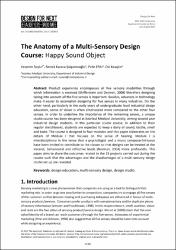| dc.contributor.author | Soylu, Yasemin | |
| dc.contributor.author | Karaca Salgamcıoğlu, Berrak | |
| dc.contributor.author | Efilti, Pelin | |
| dc.contributor.author | Kasajim, Oki | |
| dc.date.accessioned | 10.07.201910:49:13 | |
| dc.date.accessioned | 2019-07-10T19:51:49Z | |
| dc.date.available | 10.07.201910:49:13 | |
| dc.date.available | 2019-07-10T19:51:49Z | |
| dc.date.issued | 2017 | en_US |
| dc.identifier.citation | Soylu, Y., Karaca Salgamcıoğlu, B., Efilti, P. ve Kasajim, O. (2017). The anatomy of a multi-sensory design course: Happy sound object. Design Journal, 20(Supplement: 1), S1367-S1379. https://dx.doi.org/10.1080/14606925.2017.1352663 | en_US |
| dc.identifier.issn | 1460-6925 | |
| dc.identifier.issn | 1756-3062 | |
| dc.identifier.uri | https://dx.doi.org/10.1080/14606925.2017.1352663 | |
| dc.identifier.uri | https://hdl.handle.net/20.500.12511/2288 | |
| dc.description | 12th International Conference of the European-Academy-of-Design (EAD) -- APR 12-14, 2017 -- Sapienza Univ Rome, Fac Architecture, Rome, ITALY | en_US |
| dc.description | WOS: 000419738000114 | en_US |
| dc.description.abstract | Product experience encompasses all five sensory modalities through which information is received (Shifferstein and Desmet, 2008) therefore designing taking into account all the five senses is important. Besides, advances in technology make it easier to accomplish designing for five senses in many industries. On the other hand, particularly in the early years of undergraduate level industrial design education, sense of vision is often emphasized more compared to the other four senses. In order to underline the importance of the remaining senses, a unique studio course has been designed at Istanbul Medipol University, aiming second year industrial design students. In this particular studio course, in addition to their regular sketchbooks, students are expected to keep a dairy of sound, tactile, smell and taste. The course is designed in four modules and this paper elaborates on the details of Module I that focuses on the sense of hearing. Module I is interdisciplinary in the sense that a psychologist and a music composer/virtuoso have been invited to contribute to the classes so that designs can be treated at the visceral, behavioural and reflective levels (Norman, 2004) more profoundly. This paper aims to share the outcomes related to the 15 projects carried out during the course such that the advantages and the disadvantages of a multi-sensory design studio set up are revealed. | en_US |
| dc.description.sponsorship | European Academy of Design | en_US |
| dc.language.iso | eng | en_US |
| dc.publisher | Routledge Journals, Taylor & Francis Ltd | en_US |
| dc.rights | info:eu-repo/semantics/openAccess | en_US |
| dc.rights | Attribution 4.0 International | * |
| dc.rights.uri | https://creativecommons.org/licenses/by/4.0/ | * |
| dc.subject | Design Education | en_US |
| dc.subject | Multi-Sensory Design | en_US |
| dc.subject | Design Studio | en_US |
| dc.title | The anatomy of a multi-sensory design course: Happy sound object | en_US |
| dc.type | article | en_US |
| dc.relation.ispartof | Design Journal | en_US |
| dc.department | İstanbul Medipol Üniversitesi, Güzel Sanatlar Tasarım ve Mimarlık Fakültesi, Endüstriyel Tasarım Bölümü | en_US |
| dc.authorid | 0000-0001-8701-3573 | en_US |
| dc.authorid | 0000-0003-0544-798X | en_US |
| dc.authorid | 0000-0003-2267-1043 | en_US |
| dc.identifier.volume | 20 | en_US |
| dc.identifier.issue | Supplement: 1 | en_US |
| dc.identifier.startpage | S1367 | en_US |
| dc.identifier.endpage | S1379 | en_US |
| dc.relation.publicationcategory | Makale - Uluslararası Hakemli Dergi - Kurum Öğretim Elemanı | en_US |
| dc.identifier.doi | 10.1080/14606925.2017.1352663 | en_US |



















